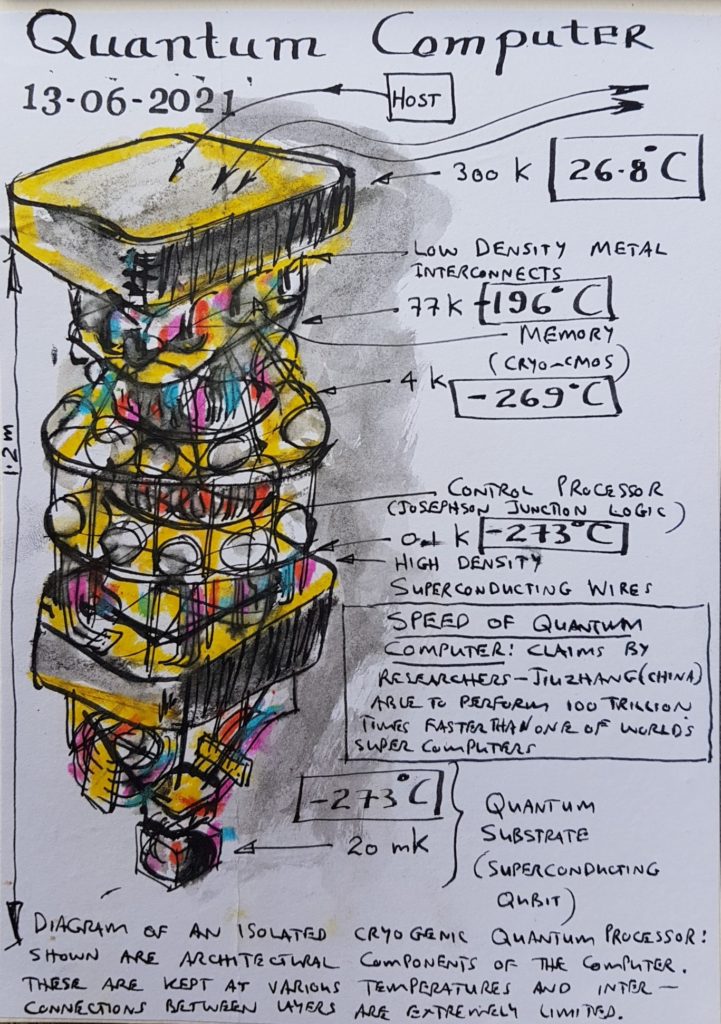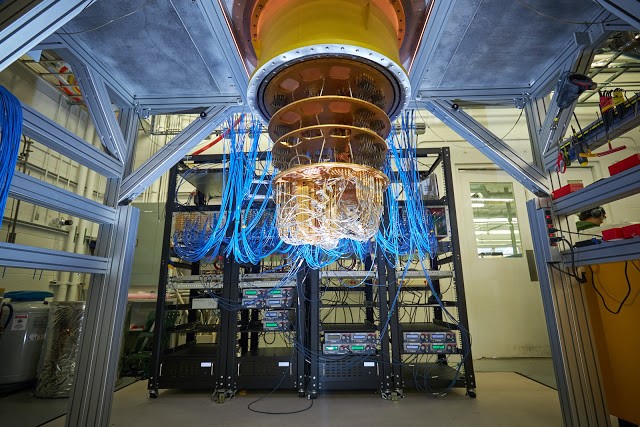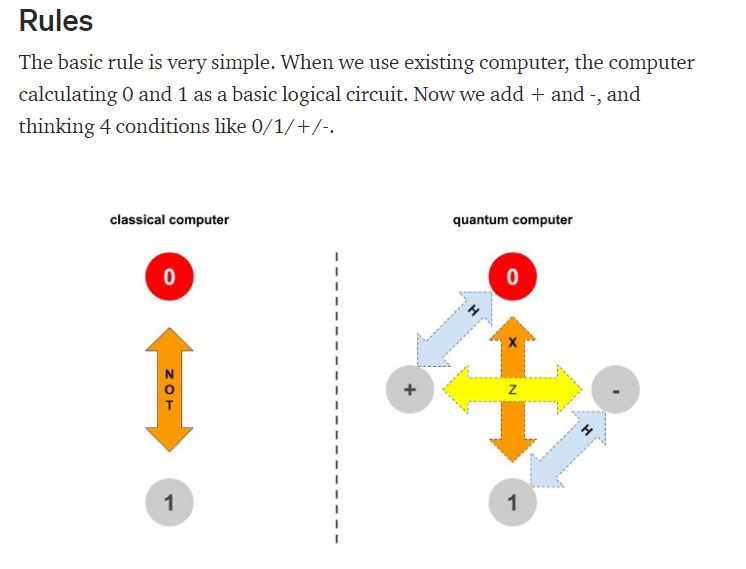
By William Van Zyl (April 2021)
Icy cold vapour is trapped in the belly of the Golden Dragon. The temperature is below –200 degrees Celsius. The tummy is cool, very cool. The intestines are frozen. Light and atoms are subjected to the cold. But, it is at this temperature that the beast obeys. It follows instructions at the speed of light. It twirls, spins and dances through computations at a devastating rate. It solves intricate and notoriously tricky problems. Albert Einstein would have been in awe if he had the opportunity to see the golden creature.
From afar, the quantum monster looks like an extravagant golden chandelier. Up closer, it seems like a steampunk light fitting from an artist’s home or business that has come alive. It contains an intricate collection of tubes and wires – probably boxes that carry light atoms. Not only electricity as we know it. Light and atoms culminate in a small container at the bottom. It has to be kept very calm. Crypto-cool. This is the power-belly. It is, in fact, one of the most sophisticated quantum computers ever built I am describing. There are several prototypes around the world today in 2021 – the race to create the first successfully quantum computer is on.
The processor inside the computers has around 50 to 120 quantum bits, or qubits, that process tasks in a (potentially) revolutionary way. The goal is to have millions of qubits working together. Usually, information is created and stored as a series of ones and zeroes – binary code as we know it. Contrary to binary, qubits can represent both values (0 and 1) simultaneously (known as superposition), which means a quantum computer can theoretically test the two simultaneously. Add more qubits, and this hard-to-believe computational power increases.
YouTube: Quantum Computers.
VIDEO: The future of Quantum Computing.
QUANTUM COMPUTING: The latest breakthroughs – 2021.
Table of Contents
Cryogenics: The Cooling of quantum computers
“[N. Summers explain] …that’s where the pumps would typically come in. The system gradually cools from top to bottom from four Kelvin – liquid-helium temperatures – to 800 milliKelvin, 100 milliKelvin and, finally, 10 milliKelvin. Inside the canister, that’s 10 thousandths of a degree above absolute zero. The wires, meanwhile, carry RF-frequency signals down to the chip. These are then mapped onto the qubits, executing whatever program the research team wishes to run. The wiring is also designed in a way to ensure that no extraneous noise – including heat – is transported to the quantum computer chip at the bottom.
In order to keep quantum computers stable, they need to be cold. That’s why the inside of D-Wave Systems’ quantum computer is -460 degrees Fahrenheit (-273.3 Celsius). According to Professor Catherine McGeoch at Amherst University, a quantum computer is “thousands of times” faster than a conventional computer.”
Credit: N Summers. Link to article: https://www.engadget.com/2018-01-09-this-is-what-a-50-qubit-quantum-computer-looks-like.html
Documentary CGTN (Chinese Quantum Computer development programme)
China Global Television Network, or CGTN, is an international media organization launched on December 31, 2016. CGTN Documentary is a Chinese pay television channel operated by Chinese State broadcaster China Central Television as a part of CGTN group of international channels, broadcasting documentaries in the English language. On April 27 2021, on the CGTN Documentary, New Zealand Sky Television broadcasted a programme on China’s exploration of Quantum Computing research and development. I viewed it – this is where the inspiration for this article comes from. It is not only the quantum computers and the vast possibilities for the future that sparked my interest, but it is the application scientific skill and the intelligence of humans it had been endowed with, that inspired this article. Humans are super talented to encode and decode.

World War 2: Japanese Cyphers
Here is an interesting story of how the Americans deciphered the secret codes of the Japanese just after the attack on Pearl Harbour in 1941.
PURPLE was an enticing, but quite tactically limited, a window into Japanese planning and policy because of the peculiar nature of Japanese policymaking prior to the War. Early on, a better tactical window was the Japanese Fleet Code (an encoded cypher), called JN-25 by U.S. Navy cryptanalysts. Breaking into the version in use in the months after December 7, 1941 (Pearl Harbour) provided enough information to lead to U.S. naval victories in the Coral Sea and Midway battles, stopping the initial Japanese advances to the south and eliminating the bulk of Japanese naval air power. Later, broken JN-25 traffic also provided the schedule and routing of the plane Admiral Isoroku Yamamoto would be flying in during an inspection tour in the southwest Pacific, giving USAAF pilots a chance to ambush the officer who had conceived the Pearl Harbour attack. And still later, access to Japanese Army messages from decrypts of Army communications traffic assisted in planning the island-hopping campaign to the Philippines and beyond.
Credit: https://en.wikipedia.org/wiki/Magic_(cryptography)

Fragment of an original Japanese Type 97 “Purple” cypher machine on display at the United States National Security Agency’s National Cryptologic Museum located in Ft. Meade, Maryland. The plaque at the base of the machine fragment reads: ” ‘Purple’ This is the largest of three surviving pieces of the famous Japanese diplomatic cypher machine. It was recovered from the wreckage of the Japanese embassy in Berlin, 1945.” Public Domain – U.S.
Back to the quantum computers of the future.
What is LOQC?
Linear Optical Quantum Computing or Linear Optics Quantum Computation (LOQC) is a quantum computation paradigm, allowing (under certain conditions, described below) universal quantum computation. LOQC uses photons as information carriers, mainly uses linear optical elements or optical instruments (including reciprocal mirrors and waveplates) to process quantum information, and uses photon detectors and quantum memories to detect and store quantum information.
What is a Photon?
In technical terms, the photon (Greek: φῶς, phōs, light) is a type of elementary particle. It is the quantum of the electromagnetic field, including electromagnetic radiation such as light and radio waves and the force carrier for the electromagnetic force. It is these particles scientists, and computer researchers are exploring in new computational frameworks. It goes beyond binary code – the microprocessors that are in our smartphones and computers.

Interior of IBM Quantum computing system. (Credit: IBM) From Flickr. IBM Research – April 2021. See more stunning images: https://www.flickr.com/photos/ibm_research_zurich/albums/72157663611181258
Difference between classical computing and quantum computing:
“The basic difference between Quantum Computer and Classical Computer is Classical Computers works with bits, and on the other hand, Quantum Computers work with Qubits. So, if we want to store data in a classical computer, it first coverts into specific combinations of 0’s and 1’s and stores that binary data into bits on our hard drive. There is a magnetic domain in the hard drive and we have magnetic polarization and can change magnetization to be pointing up or pointing down.
On the other hand, In Qubits, it can take any combination of the binary outcome using superposition, and we can of it think as a spin. Then we can imagine it as a spin up or spin down, but we can also have a superposition of up and down if it is isolated enough.“
Credit: medium.com

Google’s Sycamore processor mounted in a cryostat, recently used to demonstrate quantum supremacy and the most significant quantum chemistry simulation on a quantum computer. Photo Credit: Rocco Ceselin

Quantum computing – abstract simulation. Credit: Pixabay.
The very basics of Quantum Computing diagramatically explained.

However, there is a catch. Quantum computing is an exceptionally delicate thing since maintaining a suspended quantum particle in a superposition can only be done for about 100 microseconds. As mentioned, it also needs freezing temperatures and superconductors, not precisely something that fits in your iPhone. This kind of hardware makes quantum computers highly specialized equipment that is only really practical for particular tasks right now, things like prediction modelling and optimization problems on complicated systems with many variables.
Is quantum computing done faster than the speed of light?
“The idea is not quite as crazy as it might sound, though you may wish to limber up your mind before delving deeper. It’s based on the same principle as that of quantum entanglement — the notion that two particles on opposite sides of the universe can be linked through their quantum states such that one cannot be adequately described without the other. That is, an action on one particle instantaneously influences its counterpart, even if they are separated by light-years.“
Credit: https://www.quora.com/Is-quantum-computing-done-faster-than-the-speed-of-light
Light-Based Quantum Computer Exceeds Fastest Classical Supercomputers.
“For the first time, a quantum computer made from photons—particles of light—has outperformed even the fastest classical supercomputers. … More broadly, the ability to control photons as qubits is a prerequisite for any large-scale quantum internet.3/12/2020″.
Human’s abilities explored – intellectual abilities
Man’s super abilities to explore, research, investigate, design, test and produce are genuinely exceptional! Here is an excerpt of Deacon Gary Nelson, who encapsulates the implanted abilities given to man:
God has implanted in our souls the gift of “intellect” and the gift of a “free will,” – that is, the gift of intelligence, and the gift of making choices – and God wants us to use these gifts in his service. God desires that our intellects should be truly enlightened and instructed so that it will have a clear knowledge of who God is. God desires that we continually grow in the knowledge of his love, power, goodness, justice, and mercy. And when we have attained the knowledge of these things, the Christian will know how to adore God, how to trust God, how to follow God’s instructions, and how to thank God for all things and in all circumstances.
We demonstrate and prove that we believe by what we choose to do. We proclaim God’s revealed truth to others not only by our words, but also by our actions. Our acts of love toward others imitate God in certain ways because he not only told us that he loved us, but his Son died on the cross to prove it.
Credit: Deacon Gary Nelson (Year of Faith Liturgical Minute No. 34. The Gifts of Intellect and Free Will).
Humans are deciphering and encoding the complicated and stunningly fascinating universe God (Jehovah) has created and given to humans to manage. God gave these as gifts to humans; however, He requires accountability and stewardship.
For Christians, the issue is more profound: We know that God created the world, and it belongs to Him, not us. Because of this, we are only stewards or trustees of God’s creation, and we aren’t to abuse or neglect it.
The Bible says,
“The earth is the Lord’s, and everything in it, the world, and all who live in it” (Psalm 24:1).
Copyright © 2021 by William Van Zyl
In the Ice Cold Belly of the Golden Dragon, it Rumbles, Spins, and Twirls. Light Atoms Spark and Flash – the almost Frozen Creature is at Work.
All rights reserved. This book or any portion
thereof may not be reproduced or used in any manner
whatsoever without the express written permission of the
publisher except for the use of brief quotations in a book review.
Published by Five House Publishing (New Zealand)
First Publishing, 2021